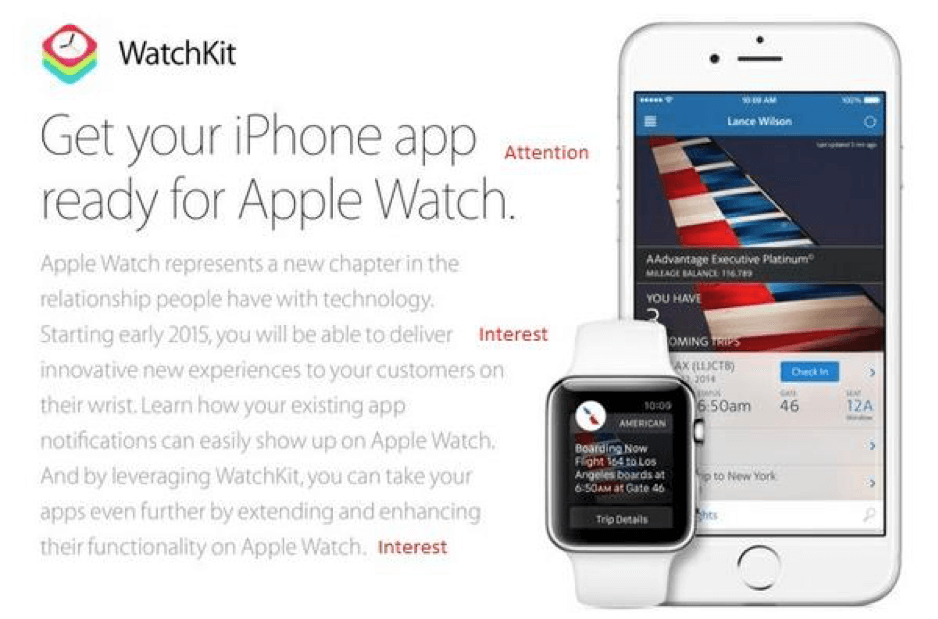We’re digging into the archives again, this time with a tried and true principle (known as AIDA) for developing messages and hitting home with your target audience.
The examples are from the time the article was written (back in early 2016) – but if you look around you, you’ll see this approach in action everywhere!
So, let’s dive right into this formula for writing your marketing materials in less time, while also increasing the likelihood of success with your message.
It’s called AIDA.
The acronym stands for:
Attention – Interrupt the mental haze your readers live in every day.
Interest – Share uncommon or fresh information that elevates awareness.
Desire – Tap an emotional need that boosts demand for what you offer.
Action – Tell your readers what to do next.
Here’s a strong example from Amazon:

Notice how every element from the formula is included. In some cases, you see pieces of the formula worked in several times.
Smart move.
In fact, if you do a good job creating desire, then you should ask for action several times.
Now look at this advertisement from WatchKit:

This piece introduces an idea, but it doesn’t create desire (i.e., appeal to an emotional need). Furthermore, there’s no way to take the next step.
I included this example because it ties into the most common elements I see missing from advertising and marketing pieces – Desire and Action.
Keep in mind, too: action doesn’t mean you just include a phone number or website address. You must give readers a reason to take the next step.
This is where Desire becomes critical.
If you need help coming up with emotional needs to target, here are eight biologically programmed desires that we all share – or what advertising consultant and trainer Drew Eric Whitman calls the “Life-Force 8”:
- Survival, the enjoyment of life, and life extension
- Enjoyment of food and beverages
- Freedom from pain, fear, and danger
- Sexual companionship
- Comfortable living conditions
- To be superior
- Care and protection of loved ones
- Social approval
Now, as we’ve stressed here before, one way to ensure prospects read your marketing content is to create a strong opening. So, here are several ideas for starting strong with your first sentence (and examples from classic ads):
Say something unexpected.
How would you like to travel the world and never pay a hotel bill for the rest of your life?
Address a potential problem.
Doctors always think twice about recommending toxic drugs and dangerous surgeries for their families. Is your health LESS important?
Include the words “you” or “your” at least once.
You’re working hard to pay of your credit card debt, but you deserve a better rate, service, and simplicity.
State a surprising fact.
If you’re lucky enough to have money set aside for a rainy day, and you’re keeping it in a savings account, you are really losing money hand over fist.
Get the idea?
A few weeks ago, I received an email pitch with an opening sentence that still baffles me. Here’s what it said:
“I’m (name removed), what we offer is a complete and comprehensive strategy without leaving any bit of any significance.”
The only reason this email caught my attention was because the opening was so weak. The wording doesn’t even make sense.
Unfortunately, this lack of appeal is pretty typical for marketing pieces. You, however, will never make this mistake again…
Here are five more starting ideas with more classic examples:
Call out your audience.
This is a private advertisement. It is meant for the tremendously ambitious man only.
Start a story.
One day years ago, my writing professor handed back me a story I had written, shook her head gravely, and said, “This is so bad it makes me want to quit teaching.”
Create curiosity.
This is an unusual document you hold in your hands.
Go against common claims.
There’s a simple first step to achieving your retirement dreams and more: stop listening to the lies of brokers and financial advisors.
Ask an open-ended question.
How much more money could you make if you also profited every time you were wrong about a trade?
Remember, these types of opening sentences can be used with any marketing piece – even when writing something as basic as an email.
Now it’s your turn.
How will you keep prospects interested and taking action on your next marketing piece?
By Tom Trush
